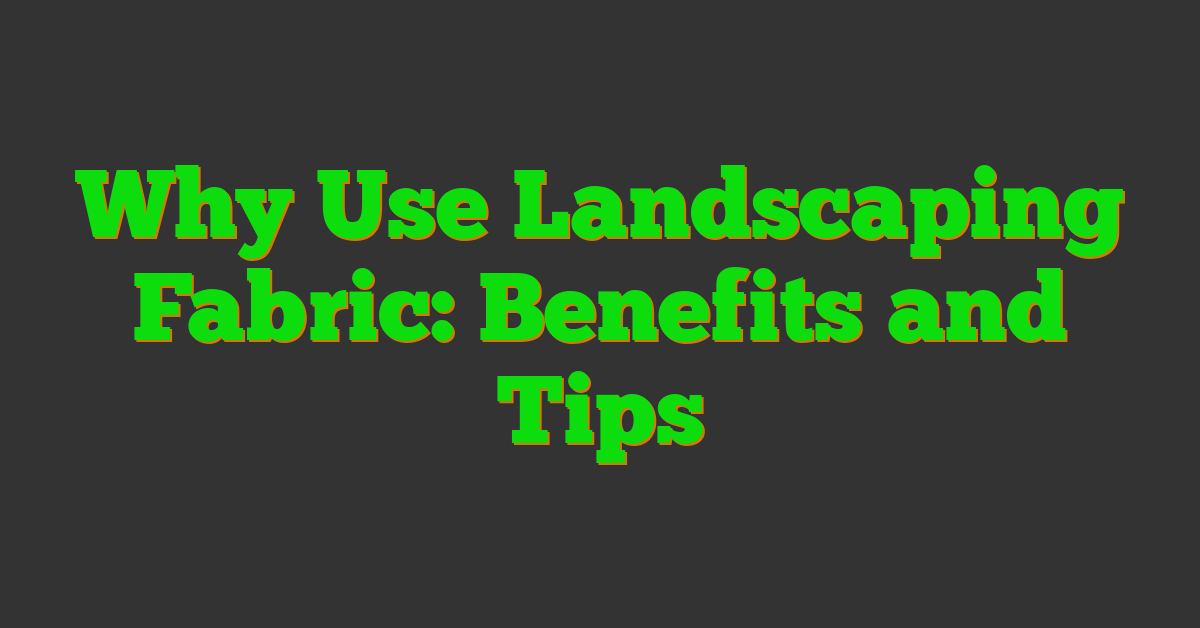If you’re looking for an easy way to keep your garden free of weeds, then you might want to consider using landscaping fabric. This material is designed to provide an extra layer of protection between your plants and the soil, preventing weeds from growing up through the ground. But that’s not all it can do. In this article, we’ll explore the many benefits of using landscaping fabric, as well as some tips for installation and usage.

One of the biggest advantages of using landscaping fabric is that it can help reduce the amount of time you need to spend weeding your garden. By blocking out sunlight and preventing weeds from taking root, you can enjoy a cleaner, more attractive outdoor space with less effort. Additionally, many types of landscaping fabric are made from environmentally friendly materials, making them a great choice for eco-conscious gardeners. Whether you’re looking to save time, reduce chemical use, or simply keep your garden looking its best, landscaping fabric is a great option to consider.
Key Takeaways
- Landscaping fabric can help reduce the amount of time you need to spend weeding your garden.
- Many types of landscaping fabric are made from environmentally friendly materials.
- Proper installation and usage can help you get the most out of your landscaping fabric.
Benefits of Landscape Fabric


If you are a gardener, you know how difficult it is to keep weeds at bay. Weeds can quickly overtake your garden and compete with your plants for nutrients and water. This is where landscape fabric comes in. Landscape fabric is a weed barrier that can help prevent weeds from growing in your garden beds.
Weed Control Efficiency
Landscape fabric is an effective weed control measure. It blocks the sunlight that weeds need to grow, preventing them from sprouting. It also inhibits the growth of existing weeds by preventing them from getting the nutrients and water they need. This means that you can spend less time weeding and more time enjoying your garden.
Soil Erosion Mitigation
Another benefit of landscape fabric is that it can help prevent soil erosion. When it rains, water can wash away soil, leaving your plants exposed and vulnerable. Landscape fabric acts as a barrier, preventing soil from washing away. This helps to keep your plants healthy and your garden looking beautiful.
Moisture Retention
Landscape fabric can also help retain moisture in your garden. It helps to prevent evaporation, which means that your plants will have access to more water. This is especially important in hot and dry climates, where water can be scarce.
Overall, landscape fabric has many advantages for gardeners. It is an effective weed barrier, helps prevent soil erosion, and retains moisture in your garden. By using landscape fabric, you can spend less time weeding and more time enjoying your beautiful garden.
Installation and Usage
https://www.youtube.com/watch?v=Yd3F-9rWLu0&embed=true
Proper Installation Techniques
When installing landscape fabric, it is important to properly prepare the area. Clear the area of any debris, weeds, and rocks. If you are using the fabric in garden beds, make sure to till the soil before laying down the fabric. This will ensure that the soil is loose and will allow the roots of your plants to grow properly.
Once the area is prepped, measure out the amount of fabric you will need to cover the area. Make sure to allow for a few inches of overlap on all sides. Lay the fabric onto the soil surface so that the edges of the pieces overlap each other by 6-8 inches.
To secure the fabric, use metal landscape pins or staples. Place them every few feet along the edges of the fabric and in the center of the fabric. This will ensure that the fabric stays in place and does not shift around.
Maintenance and Care
Proper maintenance is important to ensure that your landscape fabric lasts for a long time. Make sure to regularly check the fabric for any tears or holes. If you find any, patch them up immediately to prevent weeds from growing through.
It is also important to ensure that the fabric is properly irrigated. Water should be able to penetrate the fabric and reach the soil. If the fabric becomes too dry, it can become brittle and crack.
Finally, make sure that there is adequate air circulation underneath the fabric. This will prevent moisture from building up and causing mold or mildew to grow.
By following these installation and maintenance tips, you can ensure that your landscape fabric is installed properly and lasts for a long time. Whether you are using it in garden beds, vegetable gardens, or under rock or gravel, landscape fabric can be a great asset to your landscaping needs.
Types of Landscape Fabric
https://www.youtube.com/watch?v=D1dZmsusLqs&embed=true
When it comes to landscaping fabric, there are several options available, each with its own unique characteristics and benefits. Here are the most common types of landscape fabric:
Woven vs Non-Woven Fabrics
Woven landscape fabric is made of polypropylene or polyester and is designed to be extremely durable. It is ideal for use in areas where there is heavy foot traffic or where you need to support heavy loads, such as under patios or walkways. Woven fabric is also great for use in areas where you need to control erosion.
Non-woven landscape fabric, on the other hand, is made of a combination of polypropylene and polyester fibers that are bonded together. Non-woven fabric is lightweight and easy to install, making it perfect for use in flowerbeds and gardens. It is also an excellent choice for use in areas where you need to suppress weed growth.
Organic and Inorganic Options
Organic mulch, such as wood chips or bark, can be used as an alternative to landscape fabric. While organic mulch is biodegradable and can add nutrients to the soil, it can also attract pests and break down quickly, requiring frequent replacement.
Inorganic mulch, such as gravel or crushed stone, is another option for weed control. Inorganic mulch is long-lasting and doesn’t require replacement, but it can be more expensive than organic mulch.
« Is Landscape Fabric the Same as Weed Barrier? Explained Best Way to Kill Weeds in Landscaping: A Comprehensive Guide »
When choosing between organic and inorganic options, consider the specific needs of your landscape and your budget. Both options can be effective in suppressing weed growth and improving the appearance of your landscape.
Overall, the type of landscape fabric you choose will depend on your specific needs and the characteristics of your landscape. Consider factors like foot traffic, erosion control, and weed suppression when selecting the right landscape fabric for your project.
Environmental Considerations

When considering the use of landscape fabric, it is important to take into account its potential impact on the environment. Here are some environmental considerations to keep in mind:
Impact on Earthworms and Soil Health
Landscape fabric can have a negative impact on earthworms and soil health. Earthworms are important for soil health as they help to improve soil structure, increase nutrient availability, and enhance water infiltration. Landscape fabric can harm earthworms by reducing their access to organic matter and disrupting the soil ecosystem. Additionally, landscape fabric can prevent organic matter from breaking down and becoming compost, which is essential for healthy soil.
Alternatives to Landscape Fabric
There are several alternatives to landscape fabric that are more environmentally friendly and chemical-free. One alternative is to use cardboard or newspaper as a weed barrier. These materials are biodegradable and can be easily composted into the soil. Another alternative is to use a thick layer of mulch, such as wood chips or straw, to suppress weeds. This method also helps to retain moisture in the soil, which is beneficial for plant growth.
In conclusion, when considering the use of landscape fabric, it is important to take into account its potential impact on the environment and soil health. There are several alternatives to landscape fabric that are more environmentally friendly and chemical-free, such as cardboard, newspaper, and mulch. By choosing these alternatives, you can help to create a healthier and more sustainable garden environment.
Costs and Longevity

Analyzing Cost-Benefit
When considering whether to use landscaping fabric, one of the most significant factors to consider is the cost. The cost of landscaping fabric can vary depending on the quality and thickness of the material, but on average, it ranges from $0.10 to $0.60 per square foot. While higher-quality fabric may be more expensive upfront, it often provides better weed control and longevity, making it a worthwhile investment in the long run.
When analyzing the cost-benefit of using landscaping fabric, it’s important to consider the labor involved in installation. While it may take some time and effort to install the fabric correctly, it can save you time and money in the long run by reducing the need for weeding and other maintenance tasks.
Durability and Replacement
Another factor to consider when evaluating the cost-benefit of landscaping fabric is its lifespan and durability. Most landscape fabrics are designed to last for several years, with some high-quality fabrics lasting up to 20 years or more. However, the lifespan of the fabric can be affected by a variety of factors, including exposure to sunlight, weather conditions, and foot traffic.
When the fabric begins to break down or deteriorate, it will need to be replaced. While this can be an added expense, it’s important to consider the long-term benefits of using landscaping fabric, such as reduced weed growth and improved soil health.
In summary, when considering whether to use landscaping fabric, it’s important to analyze the cost-benefit of the investment. While the upfront cost may be higher than other options, the long-term benefits of reduced maintenance and improved soil health can make it a worthwhile investment. Additionally, choosing a high-quality fabric and properly installing it can help extend its lifespan and maximize its benefits.
Pros and Cons
https://www.youtube.com/watch?v=Ovq3oZi5O64&embed=true
When it comes to landscaping, one of the most debated topics is the use of landscape fabric. While some gardeners swear by it, others find it to be more trouble than it’s worth. In this section, we’ll explore the advantages and disadvantages of using landscape fabric in your garden.
Advantages of Using Landscape Fabric
One of the biggest advantages of using landscape fabric is that it can help to control weeds. By placing the fabric over the soil, you can prevent weed seeds from germinating and growing. This can save you time and effort in the long run, as you won’t have to spend as much time weeding your garden.
Another advantage of landscape fabric is that it can help to conserve moisture in the soil. By preventing water from evaporating, the fabric can help to keep your plants hydrated and healthy. This can be especially beneficial in hot, dry climates where water is scarce.
Disadvantages and Limitations
While there are many advantages to using landscape fabric, there are also some disadvantages and limitations to consider. One of the biggest drawbacks of landscape fabric is that it can be unattractive. If you’re looking for a natural, organic look in your garden, landscape fabric may not be the best choice.
Another limitation of landscape fabric is that it can be difficult to work with. If you’re not careful, the fabric can become tangled or bunched up, which can make it difficult to plant your garden. Additionally, landscape fabric can be expensive, especially if you have a large area to cover.
Finally, it’s important to note that landscape fabric is not a perfect solution for weed control. While it can help to prevent weed seeds from germinating, it won’t stop all weeds from growing. Additionally, if you don’t properly secure the fabric to the ground, weeds can still grow through the fabric.
Overall, whether or not to use landscape fabric in your garden is a personal choice. While there are many advantages to using it, there are also some disadvantages and limitations to consider. By weighing the pros and cons, you can make an informed decision about whether or not landscape fabric is right for your garden.
Frequently Asked Questions

What are the benefits of using landscape fabric in my garden?
Landscape fabric is a great addition to any garden because it helps to prevent weed growth, retain moisture in the soil, and regulate soil temperature. It also helps to prevent soil erosion and can provide a barrier to keep pests and other unwanted visitors out of your garden.
Can landscape fabric help with weed control?
Yes, one of the primary benefits of landscape fabric is that it helps to control weeds. By placing the fabric over the soil, it blocks sunlight and prevents weed seeds from germinating. This means you’ll have fewer weeds to worry about and can spend more time enjoying your garden.
Is it necessary to cover landscape fabric with soil or mulch?
Yes, it’s important to cover landscape fabric with a layer of soil or mulch to help hold it in place and to provide additional protection against weeds. The mulch or soil will also help to regulate soil temperature and retain moisture in the soil.
How long can I expect landscape fabric to last before it needs replacing?
The lifespan of landscape fabric can vary depending on the quality of the fabric and the conditions it’s exposed to. However, most landscape fabric should last at least 3-5 years before it needs to be replaced.
Are there eco-friendly options for landscape fabric that are biodegradable?
Yes, there are eco-friendly options for landscape fabric that are biodegradable and made from natural materials such as jute, hemp, or coconut fiber. These options are a great choice if you’re looking for a more sustainable option for your garden.
What are some alternatives to using landscape fabric for gravel pathways?
If you’re looking for an alternative to landscape fabric for your gravel pathways, you could consider using a layer of sand or crushed stone as a base layer. This will help to prevent weeds from growing up through the gravel and provide a stable base for your pathway. Another option is to use a permeable landscape fabric that allows water to flow through but still helps to prevent weed growth.












